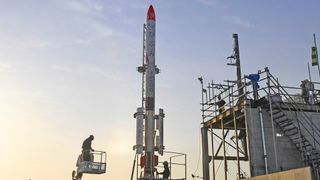Watch Japan's 1st Private Rocket Launch Into Space (Video)
The third try's a charm for Momo!
The Japanese space startup Interstellar Technologies Inc. just became the country's first private company to successfully launch a rocket into space.
In the company's third attempt to launch its experimental sounding rocket, named "Momo," Interstellar Technologies managed to get the rocket off the ground and into space. The Momo-F3 rocket lifted off from a test site near the town of Taiki on Japan's northern island of Hokkaido on May 4 at 5:45 a.m. local time (2045 GMT on May 3), company officials said in a statement.
Four minutes into the flight, the rocket reached a peak altitude of 70.5 miles (113.4 kilometers) — well beyond the edge of space — before beginning its descent back to Earth. It splashed down in the Pacific Ocean approximately 23 miles (37 km) away from the launch site after an 8-minute and 34-second flight. A launch video released by Interstellar Technologies shows the rocket's ascent to space, both from the perspective of the spectators on Earth as well as from the rocket itself. In the mission control room, workers wearing hard hats erupt with cheers as the Momo-F3 rocket passes the Kármán line, or the commonly accepted boundary of space, which is about 62 miles (100 km) high.
Related: Japan's Interstellar Technologies Goes Full Throttle Toward Small Orbital Rocket

When Interstellar Technologies first tried to launch its brand-new Momo rocket in 2017, the mission "was terminated after 66 seconds of the liftoff due to [a] glitch in the telemetry," company officials said in the statement. Although the mission was not considered a success, Momo-1 did become the first private rocket to launch from Japan.
A second attempt last summer ended in a fiery explosion when the rocket failed just a few seconds after it left the launchpad. That rocket lost its thrust almost immediately after liftoff due to a glitch with the main engine, and it exploded as it came crashing down to Earth.
The third try was the charm for Interstellar Technologies, but the Momo-F3 mission didn't come without its own fair share of hiccups. Momo-F3 was originally scheduled to launch in April, but it was postponed when engineers discovered a problem with a cryogenic valve. After they replaced a few parts, Momo-F3 was ready to fly, but "strong wind and poor weather" forced the company to delay the launch two more times.
Get the Space.com Newsletter
Breaking space news, the latest updates on rocket launches, skywatching events and more!
On May 4, the rocket was on the launchpad with the countdown clock ticking when an "anomaly" was detected 10 seconds before liftoff, and the countdown automatically stopped. Interstellar Technologies did not offer much information about the last-minute issue, but the holdup didn't last long. Momo-F3 lifted off 45 minutes later with plenty of time left to spare in its 3-hour launch window.
The $440,000 Momo launch vehicle is a small sounding rocket that stands about 32 feet (10 meters) tall and weighs just over 1 metric ton. For comparison, SpaceX's reusable Falcon 9 rocket is 230 feet (70 m) — taller than a stack of seven Momos! Because sounding rockets are typically used to launch small research payloads and science experiments into orbit, they don't need to be as big and powerful as the rockets that launch spacecraft or large satellites, and they aren't built to be reused. There were no science experiments on board for the Momo-F3 mission, because it was only a test of the rocket's capabilities.
With the success of Momo-F3, Interstellar Technologies plans to continue improving its Momo rocket series while also introducing a new one. Named "Zero," the new rocket will be able to launch small satellites that are too heavy for Momo to launch. Its first test flight is tentatively scheduled for 2020.
- Japan Taps Toyota to Build Futuristic Moon Rover
- Japanese Space Capsule Prototype Survives Fiery Fall to Earth
- Japanese Company Raises Record $90 Million for Moon Missions
Email Hanneke Weitering at hweitering@space.com or follow her @hannekescience. Follow us on Twitter @Spacedotcom and on Facebook.
Join our Space Forums to keep talking space on the latest missions, night sky and more! And if you have a news tip, correction or comment, let us know at: community@space.com.

Hanneke Weitering is a multimedia journalist in the Pacific Northwest reporting on the future of aviation at FutureFlight.aero and Aviation International News and was previously the Editor for Spaceflight and Astronomy news here at Space.com. As an editor with over 10 years of experience in science journalism she has previously written for Scholastic Classroom Magazines, MedPage Today and The Joint Institute for Computational Sciences at Oak Ridge National Laboratory. After studying physics at the University of Tennessee in her hometown of Knoxville, she earned her graduate degree in Science, Health and Environmental Reporting (SHERP) from New York University. Hanneke joined the Space.com team in 2016 as a staff writer and producer, covering topics including spaceflight and astronomy. She currently lives in Seattle, home of the Space Needle, with her cat and two snakes. In her spare time, Hanneke enjoys exploring the Rocky Mountains, basking in nature and looking for dark skies to gaze at the cosmos.
